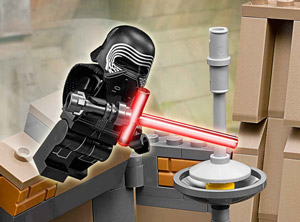LEGO
FY 2015 operating profit surges by 26% / Strong growth in all major regions / Focus on continual expansion
 The "Star Wars" range was one of last year's top sellers (Photo: Lego) |
Global expansion and new product innovations have boosted 2015 operating profits for Danish toy manufacturer Lego (Billund; www.lego.com) by 26% to DKK 12.2 bn (EUR 1.6 bn).
Revenue increased by 25% to DKK 35.8 bn with double-digit sales growth recorded in all of the group’s market regions, namely the US (Lego’s largest market), the UK, France, Brazil, China and Japan.
Markets in central and northern Europe grew at healthy single-digit rates while the only major market that saw a significant decrease (as measured in DKK) was Russia due to difficult currency conditions.
The company, which makes coloured plastic bricks, estimated that around 100m children played with Lego last year. Top selling lines were core themes such as “City”, “Star Wars”, “Ninjago”, “Friends” and “Duplo”. Lego said its new fantasy line “Elves” got off to a good start, as did “Dimensions”, which merges physical brick building with play on an interactive game console.
“We have achieved significant growth in sales every year for a decade now, and it is highly satisfactory that we can deliver yet another year of double-digit sales growth,” commented John Goodwin, executive vice president and chief financial officer. He added: “Importantly, we are also seeking to balance our short-term growth with our long-term capability development, as investments in production and organisation capacity have continued at pace in 2015 and will continue in the coming period.”
The company made several investments during 2015. In April, the group opened an expansion of its factory in Kladno / Czech Republic, which lifted capacity by 30% – see Plasteurope.com of 22.04.2015. Production also began last year at a new factory in Jiaxing / China, which is expected to be fully operational in 2017 – see Plasteurope.com of 15.01.2016. In addition, Lego is expanding factories in Mexico, Hungary and Denmark to meet rising demand – see Plasteurope.com of 23.10.2015.
Last June, Lego announced an investment of DKK 1 bn in a Sustainable Materials Centre as it aims to source sustainable alternatives to the oil-based plastics it uses currently – see Plasteurope.com of 18.06.2015. Construction of the centre, which will be built at Lego’s headquarters in Billund, is scheduled to start in 2017 with completion in 2018.
Goodwin said: “It is a complex task to find and implement new materials that do not compromise the safety, quality or durability of our current materials. We are busy building the organisation and we expect to enter into partnerships during the coming years, which hopefully means that we will see tangible actions as early as 2017.”
Over the course of the next few years, the group said it expects to grow moderately ahead of the global toy market, where gains are forecast at low single-digit rates, driven by its global expansion plans and continued focus on innovation.
e-Service:
Lego annual report 2015 as a PDF file
Revenue increased by 25% to DKK 35.8 bn with double-digit sales growth recorded in all of the group’s market regions, namely the US (Lego’s largest market), the UK, France, Brazil, China and Japan.
Markets in central and northern Europe grew at healthy single-digit rates while the only major market that saw a significant decrease (as measured in DKK) was Russia due to difficult currency conditions.
The company, which makes coloured plastic bricks, estimated that around 100m children played with Lego last year. Top selling lines were core themes such as “City”, “Star Wars”, “Ninjago”, “Friends” and “Duplo”. Lego said its new fantasy line “Elves” got off to a good start, as did “Dimensions”, which merges physical brick building with play on an interactive game console.
“We have achieved significant growth in sales every year for a decade now, and it is highly satisfactory that we can deliver yet another year of double-digit sales growth,” commented John Goodwin, executive vice president and chief financial officer. He added: “Importantly, we are also seeking to balance our short-term growth with our long-term capability development, as investments in production and organisation capacity have continued at pace in 2015 and will continue in the coming period.”
The company made several investments during 2015. In April, the group opened an expansion of its factory in Kladno / Czech Republic, which lifted capacity by 30% – see Plasteurope.com of 22.04.2015. Production also began last year at a new factory in Jiaxing / China, which is expected to be fully operational in 2017 – see Plasteurope.com of 15.01.2016. In addition, Lego is expanding factories in Mexico, Hungary and Denmark to meet rising demand – see Plasteurope.com of 23.10.2015.
Last June, Lego announced an investment of DKK 1 bn in a Sustainable Materials Centre as it aims to source sustainable alternatives to the oil-based plastics it uses currently – see Plasteurope.com of 18.06.2015. Construction of the centre, which will be built at Lego’s headquarters in Billund, is scheduled to start in 2017 with completion in 2018.
Goodwin said: “It is a complex task to find and implement new materials that do not compromise the safety, quality or durability of our current materials. We are busy building the organisation and we expect to enter into partnerships during the coming years, which hopefully means that we will see tangible actions as early as 2017.”
Over the course of the next few years, the group said it expects to grow moderately ahead of the global toy market, where gains are forecast at low single-digit rates, driven by its global expansion plans and continued focus on innovation.
e-Service:
Lego annual report 2015 as a PDF file
07.03.2016 Plasteurope.com [233522-0]
Published on 07.03.2016

 German version of this article...
German version of this article...